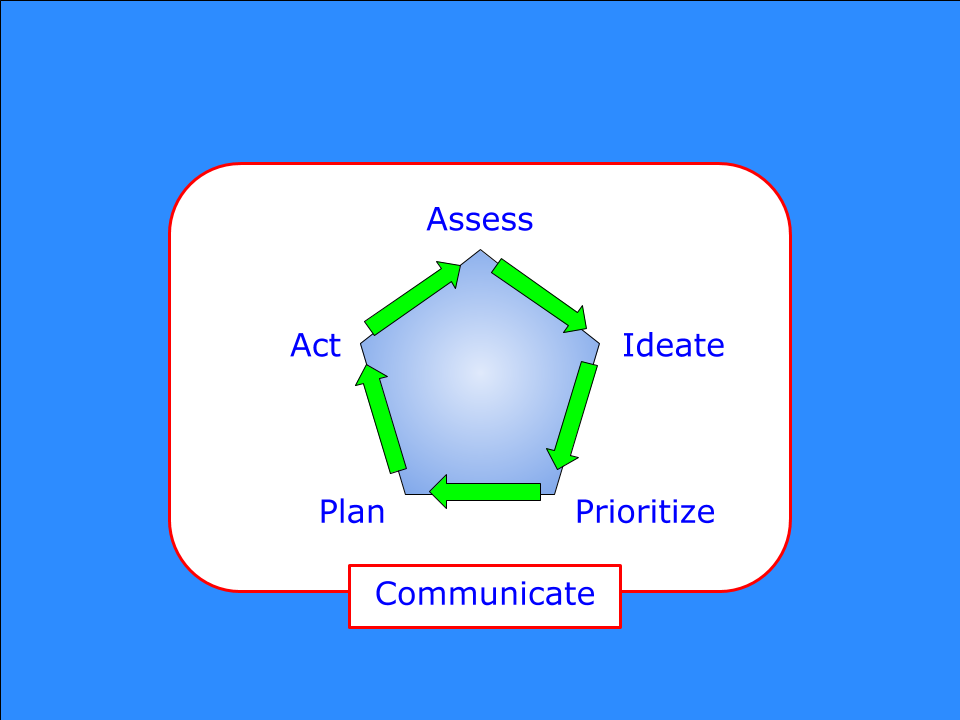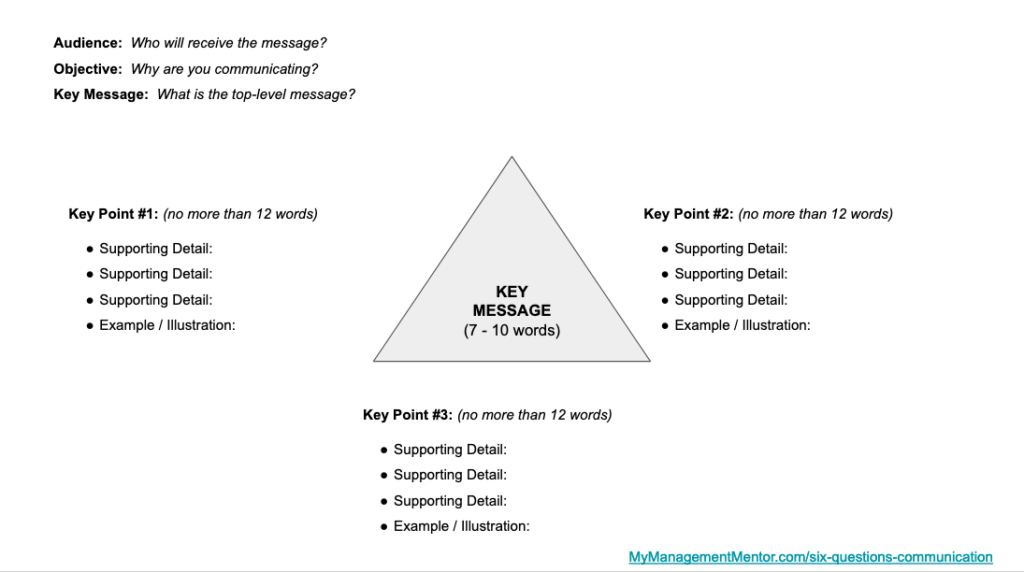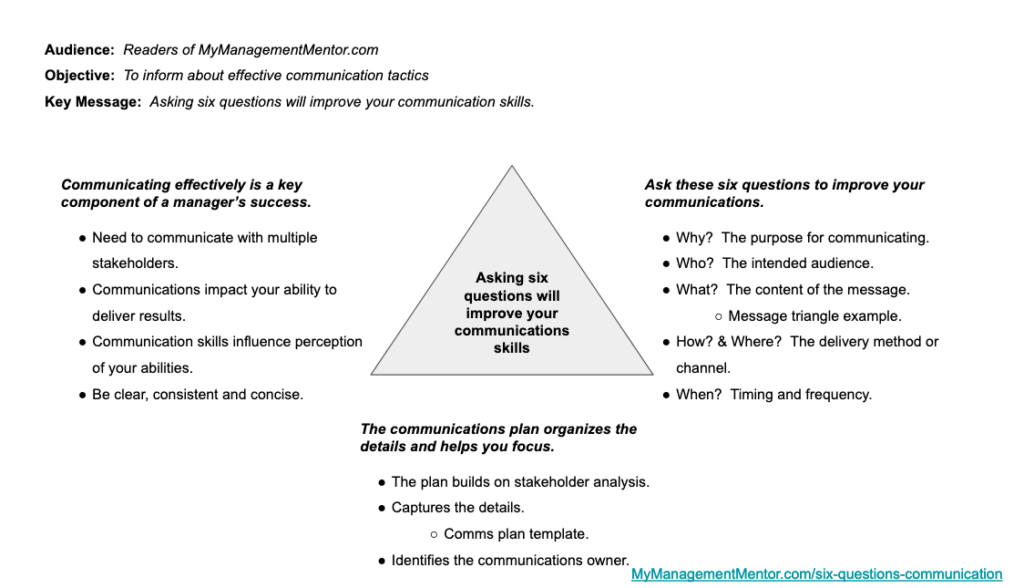Introduction
When I was in high school, I took a journalism class that was taught by a local newspaper reporter. He had a very focused view of communication skills. On the first day of class he wrote six words on the blackboard and said “Answer these questions in the first paragraph of every story and you’ll be a good journalist.” The questions were
Who? What? Where? When? How? Why?
As managers, we need to communicate with a wide variety of people and groups – our stakeholders. We need to send and receive messages on many different topics, through different channels, and for different purposes. Your ability to communicate clearly and effectively has a direct impact on your ability to deliver the results expected by your organization. Your communication skills will also influence how your abilities and results are perceived within the organization. Effective communication is thus a key component of your success as a manager.
You may be thinking to yourself, “Wait a minute, Mike. I’m not a writer and I don’t like to speak in public. How can I do this?” My suggestion is to not worry about being the “best” communicator. Instead, concentrate on being clear, consistent and concise. You can learn the skills and with practice you will improve. You probably have access to someone who can help you with creating the messages. (If you don’t, contact me and I’ll help you figure it out.) Just know that communication, like golf, is a sport where you can always improve.

The Basics of Communication – The Six Questions
Let’s consider the six questions. We don’t aspire to be journalists, but by answering the questions we can improve our communication skills and the quality of our messages.
Start with Why?
With all respect to my journalism teacher, I’m going to change the order of the questions. Following Simon Sinek’s advice, I’m going to start with Why? It is important to understand the purpose of your communications.
Some common reasons we communicate are:
- To inform. In many cases, we have information to convey to a stakeholder. This could be a project status report, an executive briefing or details of a new policy.
- To persuade. In order to deliver results, you will often have to convince others to adopt your ideas, collaborate with you or provide support for your projects.
- To initiate action. This can be giving directions to your team, delegating tasks or coaching for improved performance.
- To promote discussion. You will often need to facilitate two-way communications with others to collaborate, solve problems, develop plans and make decisions.
- To seek information. Communication is not always about telling. Many times you will communicate by asking questions.
- To inspire. Your words, delivered with empathy and sincerity, can be powerful motivators for your team.
Knowing the reason for a particular communication will inform your decisions on the other five questions. You have to know why you’re communicating in order to know who the message is intended for, what message to deliver, how and where to deliver it, and when the communication should occur.
Then Identify Who?
Determining to whom you need to communicate is an important part of providing consistent communications. By directing your communications to the right audience you help ensure that the message is most effective.
A key component in identifying who to communicate with is the process of Stakeholder Analysis. In an earlier article, I published details of the Stakeholder Analysis process and two templates that support it. If you have not read that article, I recommend taking a few minutes now to do so.
Beyond identifying your audience, Stakeholder Analysis will aid you in the other aspects of communication (What?, How?, Where? and When?) and in many other areas of your work as a manager.
Read more about Stakeholder Analysis.
Now Determine What?
Knowing why you need to communicate and to whom you’ll deliver the messages gives you the basis for determining what you will communicate – the content. If you are communicating to multiple stakeholder groups on the same topic, you will want your messages to be consistent at a high level. You will deliver the same key points, but the level of detail will vary. For example, your immediate team and close collaborators may want to know low level details but an executive audience will more likely want a summary that emphasizes results and benefits.
One tool that I have found very useful in creating consistent content is the message triangle. It can help you focus your message and identify the key points you want to deliver. The message triangle prompts you to identify:
- The objective of your communication. You will already have this because you answered the Why? question earlier.
- The key message – the top-level message. The thing that you want your audience to remember if they don’t remember anything else.
- The three most important points you want to make.
- Supporting details – facts, figures, examples – for each of the key points.
Here is an example of a blank message triangle.

Download the Message Triangle template.
All templates are free to download. No subscription required. Read more here.
Jack Martin, from the University of Washington, offers a slightly different format – the message triangle and the “message box”. He also included the suggestion to limit the length of the Key Message (what he calls the “Central Value”) and the Key Points. I’ve incorporated his idea in my template. This is one more way to make your communications concise.
With this level of detail captured, you have the basic information you’ll need to create a variety of communications – like reports, presentations, blog posts or emails – all with a consistent message for the recipients.
Here is the message triangle I prepared while planning this article.

Decide How? and Where? to deliver the message
When preparing communications, the How? and Where? questions are closely related. We’ll consider them together.
We have access to multiple channels for delivering our communications – email, written reports, presentations to groups, blog posts, as well as video or audio recordings. Selecting the proper medium will help ensure that your message is received, understood, and acted upon.
A message that is meant to inform can be a one way communication through newsletters, blog posts, or videos. These will be delivered and consumed (read, listened to or viewed by the stakeholders) often without an expectation of a response. Messages meant to promote discussion require a more real time, interactive medium like in-person presentations or Zoom calls.
Your stakeholder analysis will include an assessment of the power or influence each stakeholder has over your work. For high power stakeholders it is important to understand how they wish to receive messages. The best way to do this is to ask them about their preference. Do they want to read it, or hear it, or both? Do they want a report sent to them as either a standalone communication or as pre-reading to be followed with a live briefing?
Low power stakeholders will probably be your largest audience, so you’ll need to find ways to communicate effectively and efficiently. You could use newsletters, public presentations, video or audio recordings.
Finally, decide When?
There are two dimensions to the question of when to communicate – timing and frequency.
The timing of your messages will largely be determined by the purpose and content – the Why? and What?. Communications about urgent matters – tornado warning! – need to be sent as soon as possible. More routine messages, like project status reports, can be delivered on a set schedule.
The frequency of your communications will often be determined by the preferences of your stakeholders. Your boss may want an update on an important initiative every week while your executive steering committee members may be satisfied with a monthly briefing.
When thinking about frequency, your should also consider the need for repetition. I once worked for a manager who often said “You have to repeat your message eight times before people really hear it.” He realized that we live in a world where attention is a scarce commodity. If your purpose is to inform, persuade or prompt action, it may be necessary to send the same message multiple times through different channels to ensure it is received. Sending a single email about an important topic to a group of busy stakeholders will rarely be enough to get your message across.
Putting it all together: The communications plan.
A good communications plan can help you focus your time and attention on delivering the right messages to the right audiences at the right time. A basic format is illustrated below.

Download the Communications Plan template.
All templates are free to download. No subscription required. Read more here.
This plan builds on the earlier stakeholder analysis and identifies which stakeholders should receive communications (Who?), the reason for the communication (Why?, with notes about What?), the method and channel (How?, Where?) and timing (When?). It also captures notes about the recipients’ opinions about the topic and their likely responses to the communication. This information is especially important when preparing messages for high power stakeholders.
In addition, the plan identifies the communication owner – the person or group who will deliver the message.
Here is an example of a completed communication plan. (This builds on the stakeholder analysis example from an earlier article.)

Depending on the size of your organization, there may be others who can help you prepare and deliver the communications. If there are dedicated communications specialists in your organization, enlist their help in ensuring that your materials are well prepared.
That’s right – you don’t have to do it all by yourself!
Conclusion
As managers, we spend much of our time communicating. Your ability to deliver clear, consistent and concise messages will help you deliver the results your organization expects from you (my definition of success). Your communication skills will also influence the perception of your abilities by others in the organization, including the people who can help you advance your career.
Answering six questions – Why?, Who?, What?, How?, Where?, and When? – will help you create effective messages. Using tools like the message triangle and the communications plan will help you focus your thoughts and energy to get the most benefit from every communication.
Becoming an effective communicator requires practice as well as the recognition that there is always more to learn. But by using these actionable ideas, you can start to improve your communication skills today!
To your success,
Mike

What’s on your mind today?
Do you have a management problem or question that I could help answer?
If so, then let’s talk.
Click the button below and use the Contact form to request a complementary 30 minute chat. We’ll work together to identify some actionable ideas just for you.
